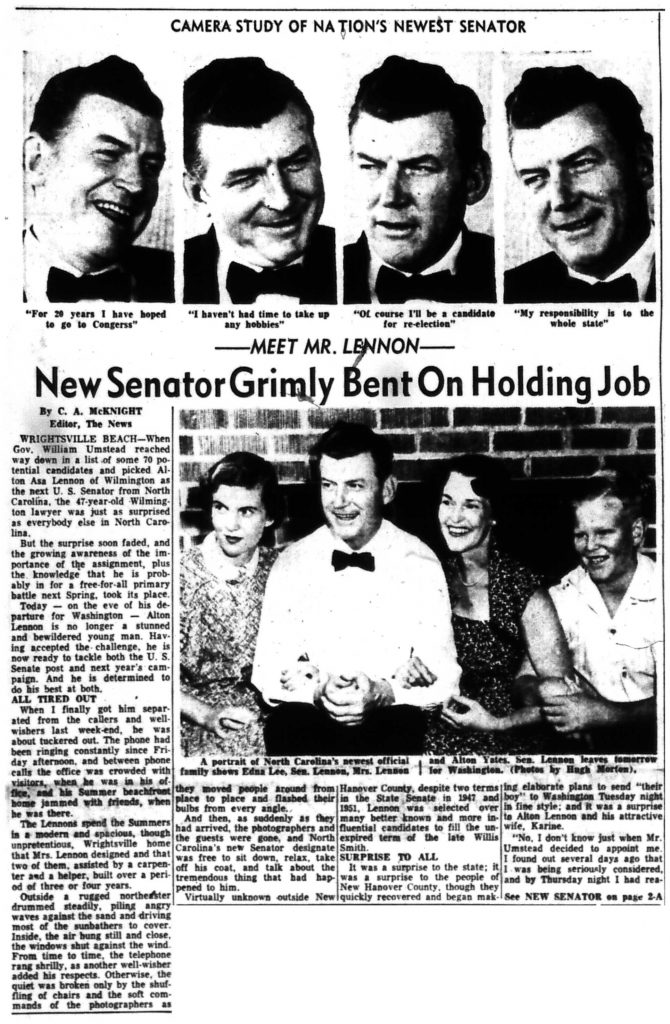
STARK NAKED — Almost everybody around Raleigh and elsewhere was caught with his pants down late last Friday afternoon when Gov. William B. Umstead, as calmly as a man reaching for a glass of water, announced that Al Lennon of Wilmington was his at-long-last choice to succeed Smith as junior U. S. Senator from North Carolina.
To be perfectly frank about it, most of us were not only caught with our pants down. We found ourselves stark naked.
So began Kidd Brewer’s “Raleigh Round-Up” column for the Thursday, July 16, 1953 issue of the Nashville Graphic (in Nash County, N. C.). We need to go back a handful of days to that previous Friday, July 10—actually back to June 26—for the start of this story. For that is the day that North Carolina’s junior senator in the United States Senate, Willis Smith, died while in office from a coronary thrombosis.
Smith’s term was set to end at the close of 1954. He was completing a term begun by J. Melville Broughton on January 3, 1949 that ended abruptly nine weeks later when Broughton died in office on March 6. Newly elected governor W. Kerr Scott appointed Frank Porter Graham to replace Broughton, but Graham lost his bid to retain the seat to Smith in a contentious run-off primary election on June 24, 1950. Smith then handily won the general election on November 7, 1950, earning him the right to complete the remaining four years of Broughton’s term.
Governor Umstead needed to replace Smith, and he kept his selection process very closed-lipped. The state’s then senior senator was Clyde R. Hoey from the western part of the state, so Umstead looked eastward for his appointee. The vacant seat had proved to be like the removable chair in the children’s game Musical Chairs, so Umstead sought an appointee who he believed could begin campaigning almost immediately for the primary that would take place in May 1954—just ten months away—win the primary, and then continue on for a full six-year term.
When Umstead announced that the relatively unknown Wilmington attorney and former state senator Alton Asa Lennon as his appointment—late on a Friday afternoon—there were few photographs of Lennon for the press to print in newspapers. Brewer noted that “there were only one or two photos of the new senator wandering around the State.”
Where on earth was the world going to get photographs of a relatively unknown Wilmingtonian who was destined for the hallowed halls of the United States Capitol? Fellow Wilmington native Hugh Morton, of course! How do we know this to be the case? Later in Brewer’s story we encounter a passage that launched me into a deeper dig to differentiate the numerous negatives made by Morton between Umstead’s announcement and Lennon’s send-off to Washington, D. C. that are extant in the Hugh Morton collection. Brewer wrote,
Hugh Morton, Wilmington photographer and tourist expert who had himself only two hours earlier been reappointed to the State Board of Conservation and Development, rushed to Lennon’s house and began flashing him in every pose but on his head. And the state editors and wire boys were already performing that act. The AP snapped up Morton’s pictures, got its wirephoto services on the ready, and in most late night editions of Saturday morning’s papers, there was old Al smiling out at you from a three-column photo.
Does Brewer’s description of the media blitz match the historical record? Is it an accurate account of how Morton’s negatives came into being? Upon searching the Morton collection finding aid, I found three listings for forty black-and-white negatives surrounding this event, with three broadly defined sets in the Morton collection finding aid:
- Lennon, Alton: Wilmington sendoff celebration to U.S. Senate, 14 July 1953
- Lennon, Alton: Various portraits, with family, etc., circa 1953
- Lennon, Alton: With Governor William Umstead, circa 1953
The first two listings are a jumble of images that span from as early as the evening of July 10 through the “send-off” on July 14, officially proclaimed by the governor as “Alston Lennon Day.” It’s important to note here that many categories of images in the Morton collection are “a jumble.” When processing the collection after its arrival, the quantity of material in the collection and its lack of internal structure did not permit our archivist, Elizabeth Hull, to refine uncounted rough groupings and descriptions for tens of thousands of items. Even today, I am hard pressed to find the time to dig too deep. In this case I needed to sort through the negatives to see what they depicted for the Morton collection preservation digitization project. A fair amount of work went into it, and I needed to write down what I learned to make sense of it all. I felt I could turn that information into a useful and informative post, and so what follows is what I’ve gathered thus far.
Let’s start with the easiest listing first: the negatives depicting Umstead and Lennon together.

News accounts stated that the governor made a surprise visit to Wilmington to meet with Lennon on Monday, July 13 during an “open house” in the offices of Star News Newspapers, the publisher of Wilmington’s two major newspapers. The only update needed for the finding aid for that group of six negatives was a change of “circa” to the exact date.
There are six negatives of Umstead interacting with Lennon, including the following image published as an Associated Press Wirephoto:
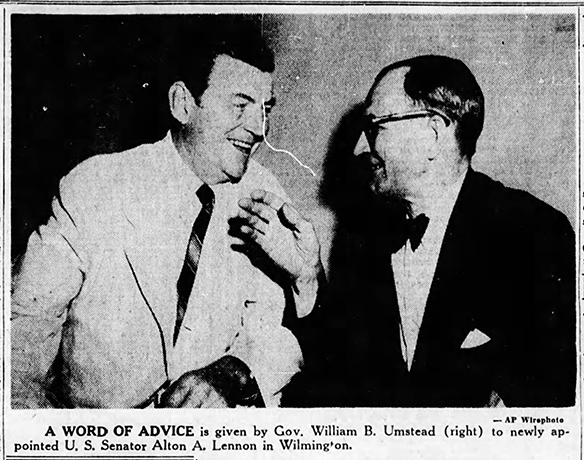
The two remaining listings in the finding aid, however, is where confusion reigned. Looking at some newspapers (Wilmington’s Morning Star and The Wilmington News, and their jointly issued Sunday Star News, plus The Charlotte News (to which Morton frequently submitted work) proved to be useful. So, too, did an eye for fashion and a bit of knowledge about photographic film manufacturing. Let’s tackle the film manufacturing process first.
Film manufacturers use notches on one corner of the film so that photographers can quickly and easily determine the emulsion side of the film. Photographers need to know the emulsion is facing the outside of the film holder (i.e., toward the lens) when they insert a sheet of film into a film holder while doing so in complete darkness. As illustrated below (but always done in the dark), if you hold the film in your hand so you can feel the notch(es) with your index finger, then the emulsion is facing upwards. (Of course there wouldn’t be an image on the film when loading new film!) The notch is also is an indication of the specific film. For this information we turn to The Acetate Negative Survey by David Horvath in 1987. According to Horvath’s survey, a single V-shaped notch on safety film made by Kodak indicates that Morton photographed using Super Pan Press, Type B.
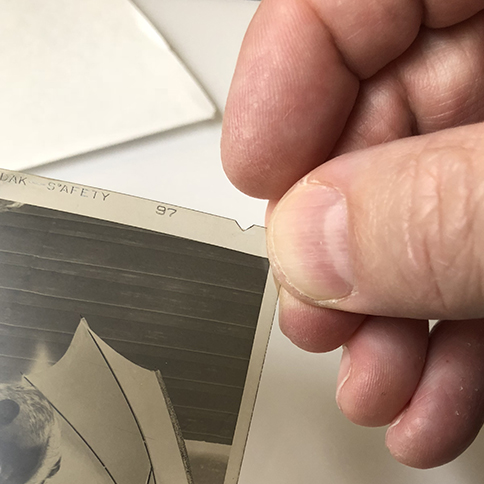
Most photographic archivists are familiar with notch codes. But also note the number to the left of the code. Not as many know what that represents, and sheet film negatives do not always have a number there. I’ve seen that number referred to both as a batch code and as a machine code: the former meaning that the manufacturer would be able to identify the emulsion batch, and the latter indicating what machine cut the film into sheets. For archivists, we can use that number to help (it’s not definitive) determine if a photographer made a group of images during the same general time period. How so? Most photographers purchased sheet film in boxes of 25 or 100, so each sheet in a box or boxes purchased at the same time will likely have the same batch/machine code. In this case all but four of the forty negatives have a single notch with the code number 97. For now, hold that thought.
The images made closest to July 10 that I found in the newspapers appeared on Sunday, July 12, meaning that photographers took them on either on the evening of the July 10 or some time on July 11. Here’s one, a “Staff Photo by Ludwig” from The Sunday Star News on July 12:
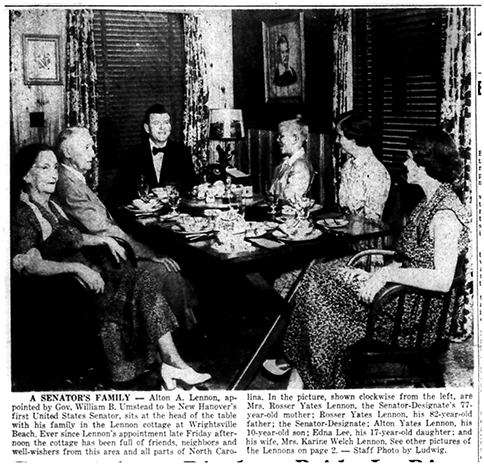
Morton took a similar group portrait of the family around the same table, but without Lennon’s parents. (You might not be able to tell from the scan from microfilm, but it’s clear in Morton’s negative that while there are rolls on the center platter, everyone’s plates and bowls are empty.) The caption identifies the location of the family portrait as Lennon’s summer cottage in Wrightsville Beach. As seen at the top of this post, The Charlotte News published a portrait of the family seated near a fireplace, wearing the same clothes, on the same page as it ran four portraits across a four-column-wide article. That setting (law office versus home) doesn’t seem to mesh with Kidd Brewer’s description. One of those single portraits may have been published in a Saturday morning newspaper that I’ve not had time to explore. If so, then Brewer’s account could be accurate.
All totaled there are nine of the similarly posed Alton Lennon portrait negatives extant in the Morton collection, and at least one other pose made it to print. Lest we forget about Hugh Morton’s other favorite go-to publication, The State, here’s another of the portraits . . .
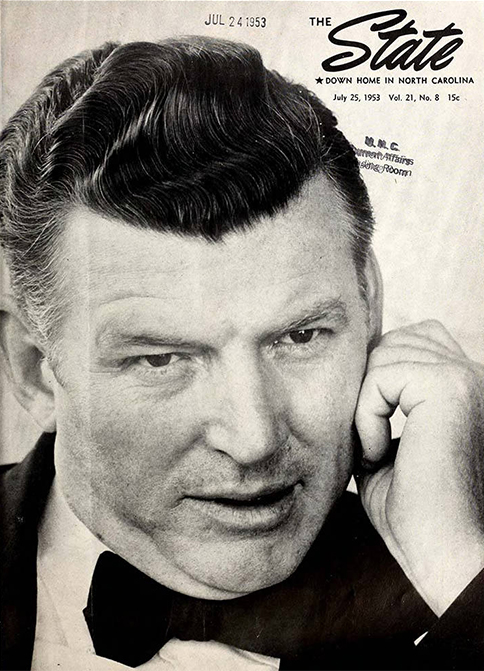
Below is a photograph published in The Wilmington News on July 13, taken by Morton but uncredited, showing a smiling Lennon with “fellow attorneys” posed in what, after consulting various other negatives in the collection, appears to be his law office in the Odd Fellows Building at 229 Princess Street. Many attorneys had their offices there because it was only a short walk to the city hall and county courthouse. The steps of Thalian Hall were just across the street on North 3rd Street.

There are several negatives made in that room, where the same composite photograph of the 1947 North Carolina Senate members is visible. Lennon was an elected member of the 1947 North Carolina Senate. In some of the negatives, Lennon’s diploma from Wake Forest College can be seen hanging on the perpendicular wall to the left.
Your eye for fashion now comes into play. You cannot tell from the picture above (as reproduced here from microfilm) but what can clearly be seen in the negative is that Lennon is wearing a double-breasted suit jacket. It may be the same as seen in this detail of a negative made by Morton on the steps of Thalian Hall below:
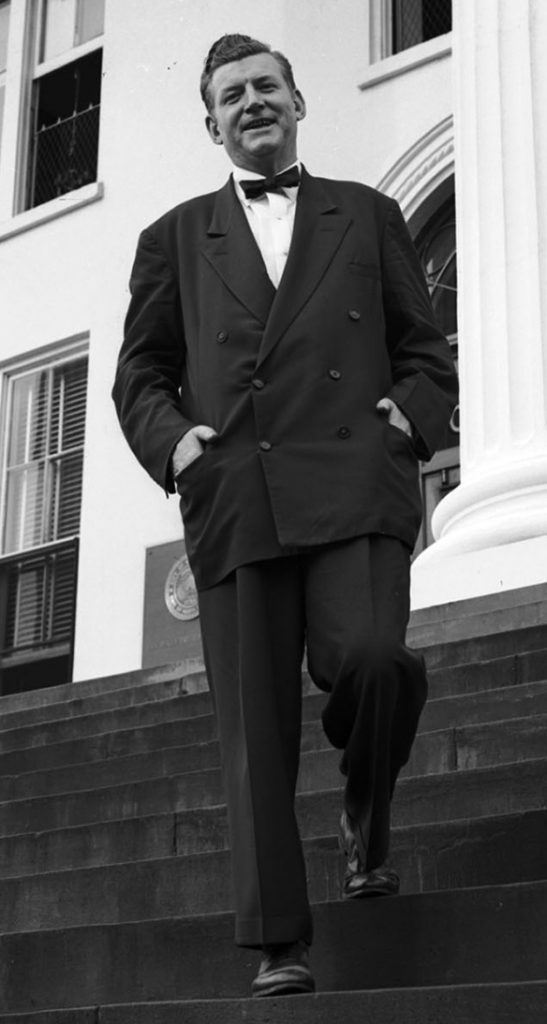
It could very well be, then, that Morton photographed Lennon on that Friday evening after the announcement when he would have been in his office with his fellow attorneys, and also on the steps of Thalian Hall.

At this point in his life, Hugh Morton was the vice president of the Wilmington Chamber of Commerce. The chamber organized a special “send off” committee and named Morton as its chairman. Festivities on July 14 began with a parade through the streets to the train station. Lennon’s car stopped for him to pose for photographers:
Now what about those four negatives with a different batch/machine code number? Here they are:
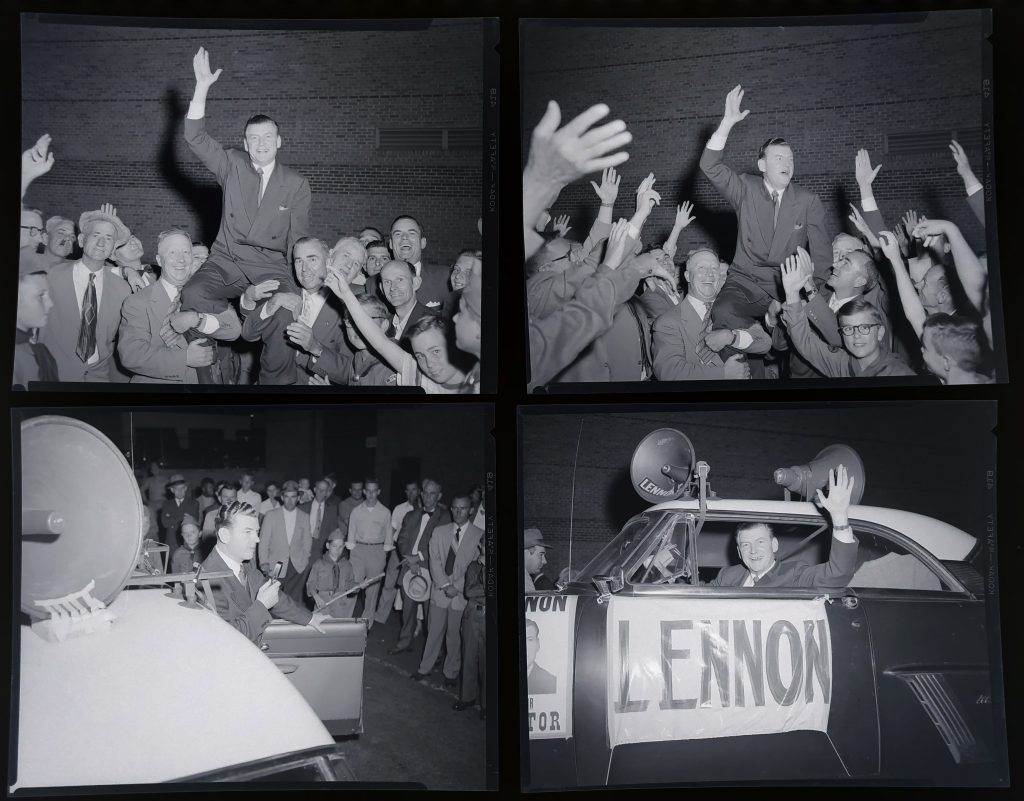
The machine code for these is 419 (not 97). Note, too, a portion of a campaign poster on the side of the car (lower right image). And that eye for fashion? Note Lennon is not wearing a bow tie, which he wears in all of the negatives made during the appointment days except during his meeting with Umstead, when he wears a light-colored suit and not a darker shade. There is enough evidence to conclude that Morton did not make these four negatives during events surrounding the Lennon announcement and send off. Lennon began campaigning soon after his appointment so we can date them from 1953 or 1954, but we cannot presume Morton made these four negatives in Wilmington. The top left negative is part of the online collection, and the metadata for that has been updated to reflect the distinction. The finding aid groupings will also be revised to reflect the new findings.
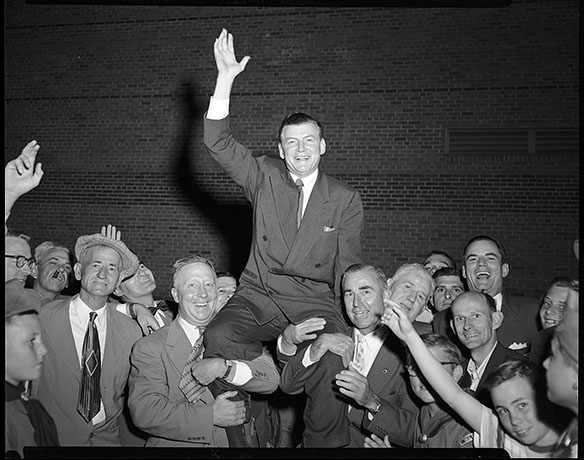
Epilog
Alton Lennon or his surrogates used at least two of Morton’s photographs during the 1954 primary. Below is a page from the April 24, 1954 issue of The State:

The image above is cropped from one of the many negatives Hugh Morton exposed in Lennon’s law office, one of two with that “Keep America Strong” illustration in the background. It’s the upper portion of a calendar, which explains the last letters of the word “COMPANY” next to his left arm.
Morton’s family portrait of the Lennons seated in front of their fireplace reappears in a political advertisement paid for by Rocky Mount Friends of U. S. Senator Alton Lennon in that city’s newspaper, The Evening Telegram, on May 24:
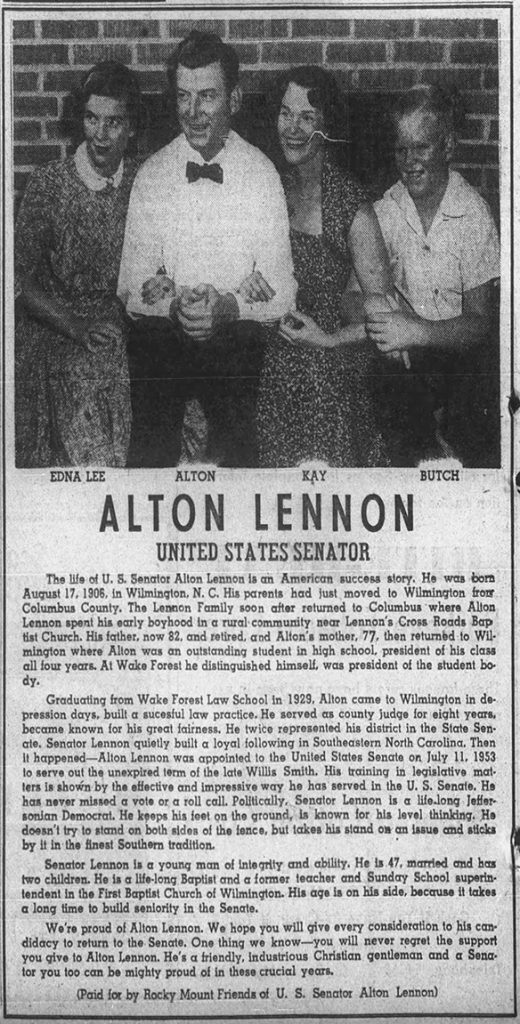
Lennon lost his bid for the full term. He and six other candidates fell to W. Kerr Scott on the Saturday, May 29 election day, with Scott securing 25,323 more votes than second place Lennon.

Maybe another Morton Mystery has been solved?!